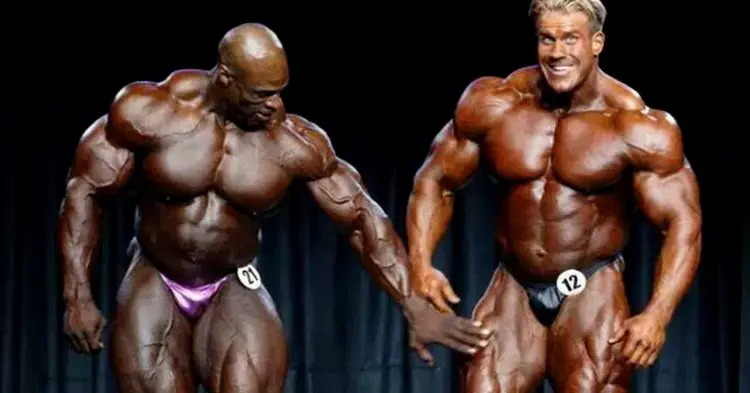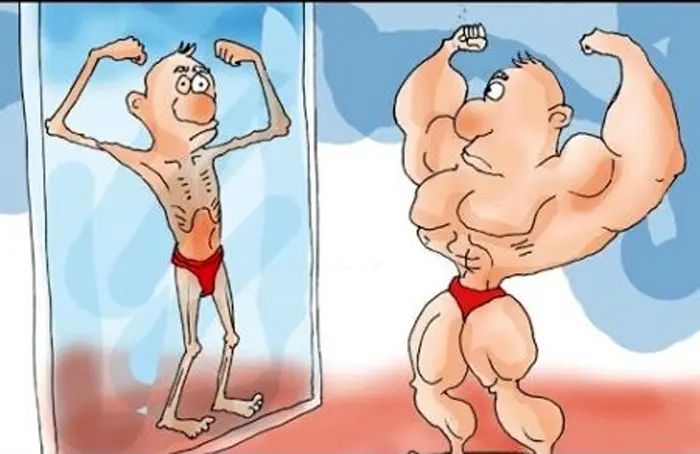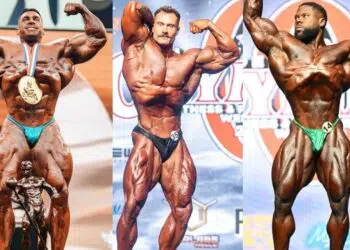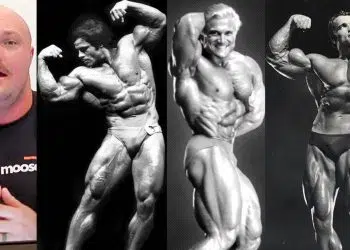Bodybuilding is usually an uphill battle. Most start training with a vague goal of “building some muscle.” However, the goalpost keeps moving, and the ideal physique feels unattainable. This often leads to physical and mental distress.
Make no mistake; this isn’t an isolated phenomenon. In fact, this is so common that we have a name for it — body dysmorphic disorder (BDD). While BDD is a general, overarching preoccupation with perceived flaws in appearance, such as skin, hair, nose, or body shape, many bodybuilders and other strength sports athletes deal with a specific form of BDD called bigorexia that’s focused on the belief that one’s body is not muscular enough. (1)
There have been numerous studies on the subject focusing on bodybuilders and how their pursuit of a bigger physique can lead them down a toxic path.
I won’t lie; as a personal trainer who has been training for over 17 years, I have had to deal with my fair share of bigorexia, and I help several clients navigate through it each month.
Contrary to what most people think, bigorexia isn’t just physiological. This condition arises in the mind and leads to unhealthy body image issues that can negatively impact your fitness journey and overall health.
In this article, I will take you over body dysmorphia and how it can lead to unhealthy body image issues.
Level Up Your Fitness: Join our 💪 strong community in Fitness Volt Newsletter. Get daily inspiration, expert-backed workouts, nutrition tips, the latest in strength sports, and the support you need to reach your goals. Subscribe for free!
The Pressure to Achieve the “Perfect” Physique
Elite bodybuilders might look like a million dollars, but many deal with constant internal struggles and a voice in their heads that constantly tells them they need to get bigger and stronger.
This usually pushes ambitious athletes down a dark path where they make performance-enhancing drugs (PEDs) an indispensable part of their routine.
Starting your first steroid cycle is incredibly easy. However, getting off these drugs isn’t easy or talked about enough.
Prolonged or incorrect gear use can lead to hormonal imbalances, which can have far-reaching consequences. This is one of the biggest reasons why we hear of the untimely deaths of so many bodybuilders competing in untested federations.
You must take a step back and think about why elite athletes in other sports are in peak physical shape, but competitive bodybuilders who train every day and never miss a meal are losing their lives over something that is so inherently ‘healthy.’
What Leads To Body Dysmorphia
Bodybuilding is all about aesthetics, and there are no performance parameters. Plus, if you are a competitive athlete, this can get even more messy for you, as your success depends on someone else’s idea (read: judge) of an ideal physique.
This, combined with the rise of social media and fitness influencers who maintain single-digit body fat throughout the year, set unrealistic body standards.
Remember, an aesthetically appealing body is not always healthy.
Getting into peak physical condition often involves staying in a substantial caloric deficit, increasing the possibility of nutrient deficiencies that can be catastrophic for your health.
Body-Image Issues and a Negative Relationship With Food
People who live and breathe bodybuilding are constantly tweaking their diet and training regime to get leaner and more muscular. However, these folks are just one wrong turn away from developing an eating disorder.
You’ve probably seen photos of extremely skinny people on social media with visible ribs and not an ounce of muscle or fat on their bodies. Most of these folks have developed an unhealthy relationship with food, meaning they consider food (especially carbs and fats) the bane of their existence.
Coach Tip: You must be extremely careful with these people. A negative remark about how they look can trigger a downward spiral of self-criticism and negative self-talk, possibly worsening their condition.
Avoid diets or packaged foods that promise quick fixes or miracle cures. Fad diets do more harm than good. At the same time, be wary of overly restrictive diets, binge eating, or purging. Follow a diet that suits your lifestyle and that you can stick to for the long term.
Building the ideal physique puts you under constant pressure to ensure an optimal diet and training routine. Since bodybuilding is an individual sport, this pressure can leave you feeling isolated and overwhelmed.
Muscle Dysmorphia: The Bodybuilder’s Obsession
Bigorexia is a constant mental struggle where the mirror begins to dictate your self-worth. I know several jacked guys who look into the mirror but see a frail body. The sad part is that bodybuilders are encouraged to look into the mirror and find flaws in their physiques.
Don’t believe me? Here is what the seven-time Mr. Olympia Arnold Schwarzenegger had to say:
Level Up Your Fitness: Join our 💪 strong community in Fitness Volt Newsletter. Get daily inspiration, expert-backed workouts, nutrition tips, the latest in strength sports, and the support you need to reach your goals. Subscribe for free!
“When I look in the mirror, I throw up. I was already so critical of myself, even when I was in top physical shape,” Schwarzenegger told Cigar Aficionado magazine. “I’d look in the mirror after I won one Mr. Olympia after another and think, ‘How did this pile of s**t win?’ I never saw perfection. There was always something lacking.”
Competitive bodybuilding is the perfect breeding ground for body dysmorphia. After all, every athlete is chasing the ideal physique that resides in the mind of a judge, and competitors are constantly compared to each other, if not on stage, then on social media. This creates constant pressure to remain in peak physical condition throughout the year, even though it might sacrifice their health.
It is no secret that many people start lifting weights to build confidence or compensate for other physical characteristics. A study found that individuals with unmet basic needs were more likely to develop muscle dysmorphia symptoms. (2)
Not only that, the drive for more muscle gains intensified the relationship between unmet needs and muscle dissatisfaction leading to unhealthy body image concerns.
A 2022 research found that 5.7 percent of male bodybuilders deal with muscle dysmorphia. Interestingly, the use of protein powder at a young age increased the risk of muscle dysmorphic disorder. (3)
Symptoms and Characteristics of Body Dysmorphia
This list will help you determine if you are dealing with bigorexia:
- Constant Body Checking: If you check out your muscles in the mirror throughout the day, you might have a problem. Also, how often do you flex your muscles?
- Obsessing Over Exercise and Diet: People who cannot stop thinking about working out or spend a huge chunk of time calculating calories from different foods are more likely to develop bigorexia.
- Social Isolation: Many avoid going out to eat with friends and family while dieting. Prolonged social withdrawal is a big red flag and is an absolute disaster if it is accompanied by fear of judgment or comparison.
- Anxiety and Depression: Being overly concerned about your fitness progress can cause psychological distress. Frequent mood swings are also a cause for concern.
The Role of Performance-Enhancing Drugs in Bigorexia
When you are trying to maximize your potential and best other athletes (on social media and on stage), you adopt all means necessary to achieve your objectives.
Anabolic steroids were first used in sports in 1889, and their use has grown multifold since then. These drugs can boost muscle growth and strength and enhance recovery, which are key to building a chiseled physique.
However, PEDs can cause hormonal fluctuations, which can lead to several physical and psychological issues like low natural testosterone production, gynecomastia, acne, hair loss, anxiety, depression, and obsessive-compulsive tendencies. (4)
While steroids might help you build muscle tissue, the trade-offs are too big to ignore. Drugs can put you in a body dysmorphia vicious cycle. Many athletes encounter severe bigorexia when they lower their PED doses. Things are even worse when they are off-cycle. This is one of the reasons why most people can never quit gear use.
Breaking the Body Dysmorphia Cycle: Seeking Help and Finding Balance
Here is how you can break free from body dysmorphia:
Comparison is the Thief of Joy
Dr. Mike Israetel, Ph.D. in Sport Physiology, explains that genetics and steroids use play a big role in how people look, and you don’t know what that is for the person you are comparing yourself to.
Focus on your own progress over time. Set realistic goals for yourself and track your progress. Don’t get discouraged if you don’t look like someone else because everyone’s genetics are different.
Cut out social media from your life if you have to. Constantly being bombarded with new, cutting-edge techniques to build the perfect physique subconsciously makes you feel dissatisfied with your current shape, increasing the risk of body dysmorphia.
Be Patient and Consistent
Two-time Figure Olympia champion Erin Stern blasted social media fitness influencers for fostering unrealistic expectations while achieving those results by potentially unhealthy or unsustainable methods.
“We are living in an attention economy, and people will do whatever it takes to get attention,” said Stern.
Set SMART (specific, measurable, attainable, relevant, and time-bound) goals. Be patient, consistent, and disciplined to ensure you hit your objectives. Then, reevaluate your goals based on your progress. Moving the goalpost consistently without acknowledging your improvements causes dissatisfaction and increases the possibility of body dysmorphia.
Gratitude and Appreciation
You are doing something that most people can only dream of. Whenever you are disappointed with how you look, you must remind yourself that true fulfillment lies beyond just the pursuit of an idealized physique.
Seek Professional Help
I cannot emphasize this enough — mental issues are just as severe as physiological ones. Body dysmorphia can often cause despair, hopelessness, and even suicidal thoughts in extreme cases.
Chronic bigorexia is a serious condition. If you can relate to the BDD or bigorexia symptoms detailed in this article or know someone who is dealing with it, you should seek professional help.
Learning how to overcome distorted thoughts associated with bigorexia involves unlearning and relearning several concepts. It takes time and patience, and you must stick with it to ensure optimal healing.
Conclusion
Many bodybuilders knowingly or unknowingly grapple with body image issues and muscle dysmorphia. Don’t confuse bigorexia with a normal desire to get bigger and stronger. If left unchecked, these can significantly impact your quality of life and overall health and well-being.
Prevent body dysmorphia by starting with an objective fitness goal and using performance-based assessment metrics. Prioritize overall physical and mental health over just aesthetic objectives.
Reassess your goals after you’ve hit all the benchmarks. Remember, appreciating your physique and being grateful for your progress will keep you grounded and away from bigorexia.
If you have any questions about body dysmorphia, post them in the comments below, and I’ll be happy to help!
References:
- Vasiliu O. (2023). At the Crossroads between Eating Disorders and Body Dysmorphic Disorders Case of Bigorexia Nervosa. Brain sciences, 13(9), 1234. https://doi.org/10.3390/brainsci13091234
- Selvi, K., Bozo, Ö. The dark side of bodybuilding: the role of bodybuilding activities in compensation of frustrated basic psychological needs. Motiv Emot 44, 190–208 (2020). https://doi.org/10.1007/s11031-019-09805-6
- Duran, S., & Öz, Y. C. (2022). Examination of the association of muscle dysmorphia (bigorexia) and social physique anxiety in the male bodybuilders. Perspectives in psychiatric care, 58(4), 1720–1727. https://doi.org/10.1111/ppc.12980
- Karagun B, Altug S. Anabolic-androgenic steroids are linked to depression and anxiety in male bodybuilders: the hidden psychogenic side of anabolic androgenic steroids. Ann Med. 2024;56(1):2337717. doi:10.1080/07853890.2024.2337717










